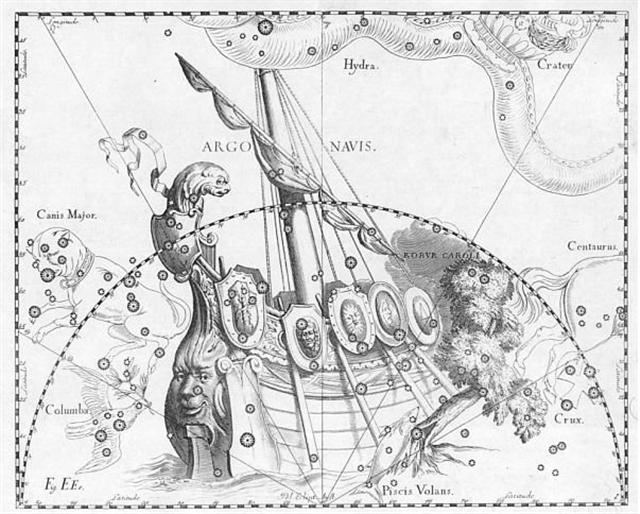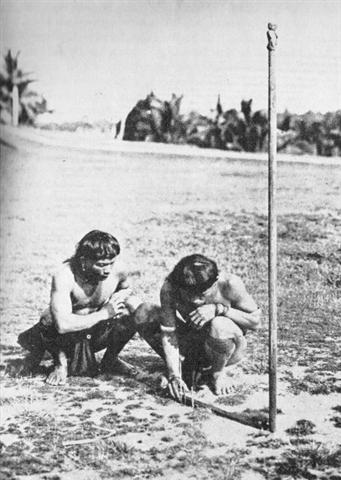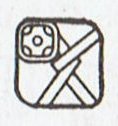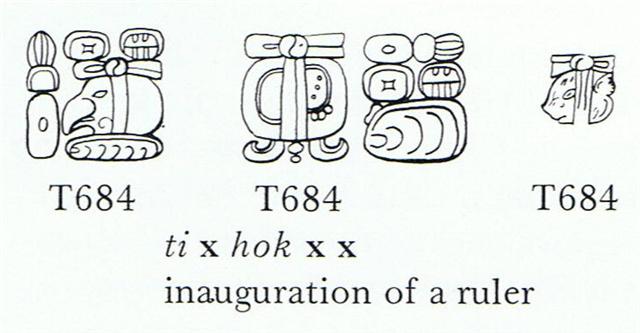2. The cross has its horizontal beam oriented 90° away from the vertical 'spear', a perfect alignment. But Taetagaloa found the 'canoe' to be crooked: ... The child nursed and tended grows up, is able to go and play. Each day he now goes off a bit further away, moving some distance away from the house, and then returns to their house. So it goes on and the child is fully grown and goes to play far away from the place where they live. He goes over to where some work is being done by a father and son. Likāvaka is the name of the father - a canoe-builder, while his son is Kiukava. Taetagaloa goes right over there and steps forward to the stern of the canoe saying - his words are these: 'The canoe is crooked.' (kalo ki ama). Instantly Likāvaka is enraged at the words of the child. Likāvaka says: 'Who the hell are you to come and tell me that the canoe is crooked?' Taetagaloa replies: 'Come and stand over here and see that the canoe is crooked.' Likāvaka goes over and stands right at the place Taetagaloa told him to at the stern of the canoe. Looking forward, Taetagaloa is right, the canoe is crooked. He slices through all the lashings of the canoe to straighten the timbers. He realigns the timbers. First he must again position the supports, then place the timbers correctly in them, but Kuikava the son of Likāvaka goes over and stands upon one support. His father Likāvaka rushes right over and strikes his son Kuikava with his adze. Thus Kuikava dies. Taetagaloa goes over at once and brings the son of Likāvaka, Kuikava, back to life. Then he again aligns the supports correctly and helps Likāvaka in building the canoe. Working working it is finished ... Taetagaloa is not (tae) Tagaroa, he is a son in the light, where sight can be used. He therefore can determine with precision the correct angles. To make his point he brings the father to observe the canoe from its stern. We can suspect this point of reference to be Canopus: ... At the end of the Golden Age (Krita Yuga) a class of Asura who had fought against the 'gods' hid themselves in the ocean where the gods could not reach them, and planned to overthrow the government. So the gods implored Agastya (Canopus, alpha Carinae = Eridu) for help. The great Rishi did as he was bidden, drank up the water of the ocean, and thus laid bare the enemies, who were then slain by the gods. But now, there was no ocean anymore! Implored by the gods to fill the sea again, the Holy One replied: 'That water in sooth hath been digested by me. Some other expedient, therefore, must be thought of by you, if ye desire to make endeavour to fill the ocean ...
The four-wheeled wain is one symbol for the cosmic structure, the hull of a ship (or canoe) is another. Such structures are calendars, maps of the sky roof of time. Constructing a ship (or a wain) is work for a carpenter. Timbers are needed. These beams are to be aligned according to the visual cues. On Easter Island, we know, a new 'house' - also a construction for a carpenter - should be built in Ko Ruti ('May') to be ready for midsummer: ... Ure Honu was amazed and said, 'How beautiful you are! In the head of the new bananas is a skull, painted with yellow root and with a strip of barkcloth around it.' Ure Honu stayed for a while, (then) he went away and covered the roof of his house in Vai Matā. It was a new house. He took the very large skull, which he had found at the head of the banana plantation, and hung it up in the new house. He tied it up in the framework of the roof (hahanga) and left it hanging there ... North of the equator the time for building a new home was in midwinter: ... In the morning of the world, there was nothing but water. The Loon was calling, and the old man who at that time bore the Raven's name, Nangkilstlas, asked her why. 'The gods are homeless', the Loon replied. 'I'll see to it', said the old man, without moving from the fire in his house on the floor of the sea ... But later, in what could have been a more degenerate time, it seems to have been enough to renew the old houses: ... When it was evident that the years lay ready to burst into life, everyone took hold of them, so that once more would start forth - once again - another (period of) fifty-two years. Then (the two cycles) might proceed to reach one hundred and four years. It was called 'One Age' when twice they had made the round, when twice the times of binding the years had come together. Behold what was done when the years were bound - when was reached the time when they were to draw the new fire, when now its count was accomplished. First they put out fires everywhere in the country round. And the statues, hewn in either wood or stone, kept in each man's home and regarded as gods, were all cast into the water. Also (were) these (cast away) - the pestles and the (three) hearth stones (upon which the cooking pots rested); and everywhere there was much sweeping - there was sweeping very clear. Rubbish was thrown out; none lay in any of the houses ... The reason for the crooked canoe (the faulty cosmic map) was not that it was old, but that it was wrongly aligned. At midsummer the year should be determined correctly by a gnomon:
(Joseph Needham, Science and Civilisation in China, vol. 3.) The skull of Hotu Matua was painted yellow (kan) - as the face of Moon I think - and it had a strip of barkcloth wrapped around. The month Pop possibly was illustrated with such ideas in mind:
I also remember the so-called 'toothache glyph':
"... Proskouriakoff (1960, pp. 456-457 and elsewhere) has shown that certain dates which seem to be associated with the beginnings of reigns are accompanied by the 'toothache glyph' [T684] with a wide variety of infixes, including the kal glyph. Cordan (1963a, pp. 45, 49) suggests the 'toothache glyph' is hok + kal (Ticul dictionary, hokal, 'bound together'; Tzotzil hokol, assimilated form, 'hung up'). More recently, Barthel (1968a, p. 136) has pointed out that hok is found as a Yucatec root meaning 'to put in office'. This makes it virtually certain that the reading hok is correct. If the offering scenes are connected with divination, it may be relevant that Tzeltal -jok'iy is 'preguntar' ('to ask a question')." (Kelley, Deciphering the Maya Script.) Maybe it was considered necessary for a new ruler to be wrapped in cloth in order to be swaddled like a newborn baby boy. North of the equator it should be winter solstice and south of the equator summer solstice. |



